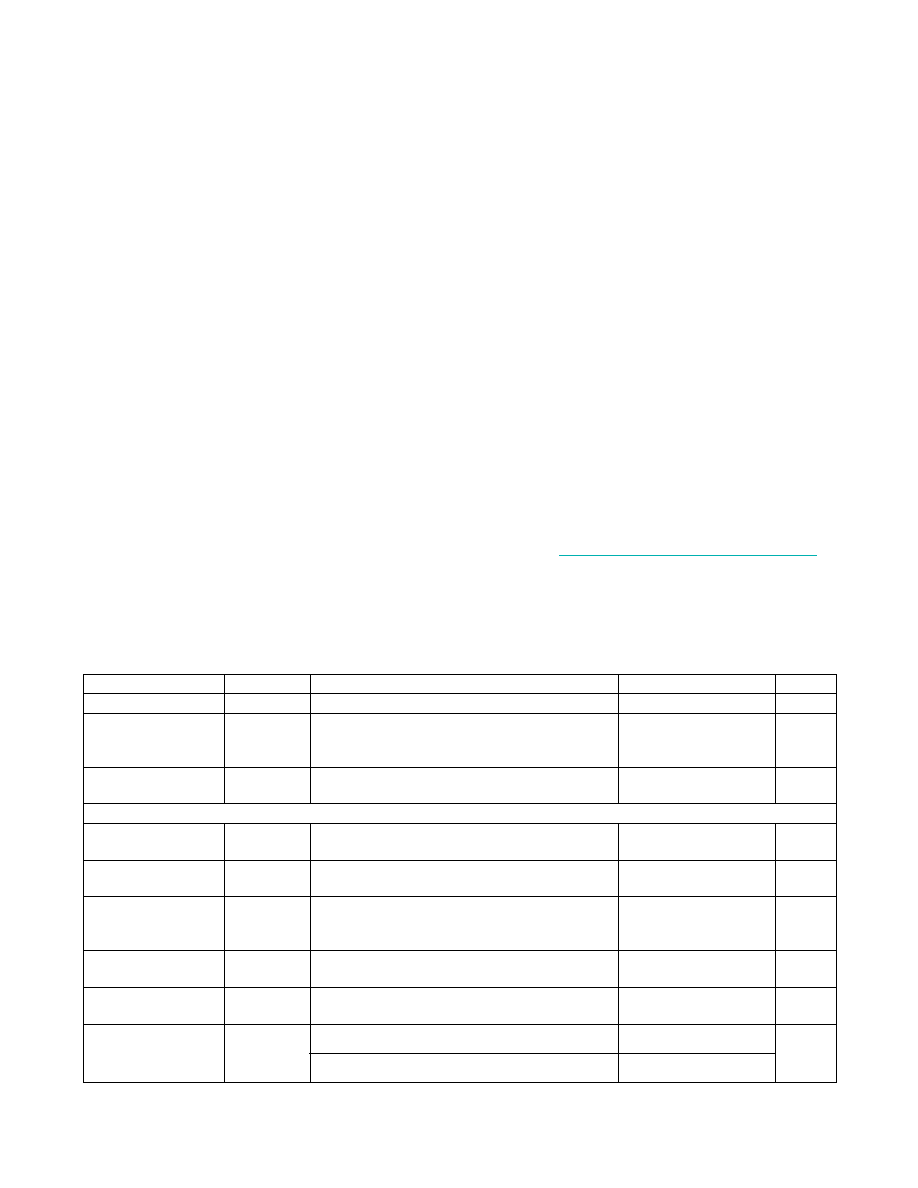- 您現(xiàn)在的位置:買賣IC網(wǎng) > PDF目錄1936 > MAX14770EATA+T (Maxim Integrated Products)TXRX PROFIBUS RS-485 8-TDFN PDF資料下載
參數(shù)資料
| 型號(hào): | MAX14770EATA+T |
| 廠商: | Maxim Integrated Products |
| 文件頁數(shù): | 9/16頁 |
| 文件大?。?/td> | 0K |
| 描述: | TXRX PROFIBUS RS-485 8-TDFN |
| 產(chǎn)品培訓(xùn)模塊: | Lead (SnPb) Finish for COTS Obsolescence Mitigation Program |
| 標(biāo)準(zhǔn)包裝: | 1 |
| 類型: | 收發(fā)器 |
| 驅(qū)動(dòng)器/接收器數(shù): | 1/1 |
| 規(guī)程: | 多協(xié)議 |
| 電源電壓: | 4.5 V ~ 5.5 V |
| 安裝類型: | 表面貼裝 |
| 封裝/外殼: | 8-WDFN 裸露焊盤 |
| 供應(yīng)商設(shè)備封裝: | 8-TDFN-EP(3x3) |
| 包裝: | 標(biāo)準(zhǔn)包裝 |
| 其它名稱: | MAX14770EATA+TDKR |

2
Maxim Integrated
High-ESD Profibus RS-485 Transceiver
MAX14770E
Stresses beyond those listed under “Absolute Maximum Ratings” may cause permanent damage to the device. These are stress ratings only, and functional
operation of the device at these or any other conditions beyond those indicated in the operational sections of the specifications is not implied. Exposure to absolute
maximum rating conditions for extended periods may affect device reliability.
(Voltages referenced to GND.)
VCC.......................................................................-0.3V to +6.0V
RE, RO.......................................................-0.3V to (VCC + 0.3V)
DE, DI ...................................................................-0.3V to +6.0V
A, B.....................................................................-8.0V to +13.0V
Short-Circuit Duration (RO, A, B) to GND .................Continuous
Continuous Power Dissipation (TA = +70NC)
SO (derate 7.6mW/NC above +70NC) .........................606mW
TDFN (derate 24.4mW/NC above +70NC) .................1951mW
F
MAX (derate 4.8mW/NC above +70NC)..................387.8mW
Operating Temperature Range
MAX14470EESA...............................................-40NC to +85NC
MAX14470EG_A............................................. -40NC to +105NC
MAX14470EATA............................................. -40NC to +125NC
Storage Temperature Range............................ -65NC to +150NC
Junction Temperature Range........................... -40NC to +150NC
Lead Temperature (soldering, 10s) ................................+300NC
Soldering Temperature (reflow) ......................................+260NC
ELECTRICAL CHARACTERISTICS
(VCC = +5V Q10%, TA = TMIN to TMAX, unless otherwise noted. Typical values are at VCC = +5V, TA = +25NC.) (Note 2)
ABSOLUTE MAXIMUM RATINGS
Note 1: Package thermal resistances were obtained using the method described in JEDEC specification JESD51-7, using a four-layer
board. For detailed information on package thermal considerations, refer to www.maximintegrated.com/thermal-tutorial.
PACKAGE THERMAL CHARACTERISTICS (Note 1)
SO
Junction-to-Ambient Thermal Resistance (
qJA)........132°C/W
Junction-to-Case Thermal Resistance (
qJC)...............38°C/W
MAX
Junction-to-Ambient Thermal Resistance (
qJA).....206.3°C/W
Junction-to-Case Thermal Resistance (
qJC)...............42°C/W
TDFN
Junction-to-Ambient Thermal Resistance (
qJA)..........41°C/W
Junction-to-Case Thermal Resistance (
qJC).................8°C/W
PARAMETER
SYMBOL
CONDITIONS
MIN
TYP
MAX
UNITS
Power-Supply Range
VCC
4.5
5.5
V
Supply Current
ICC
DE = 1, RE = 0 or
DE = 0, RE = 0 or
DE = 1, RE = 1; no load
2.5
4
mA
Shutdown Supply
Current
ISH
DE = 0, RE = 1
15
F
A
DRIVER
Differential Driver
Output
|VOD|
RL = 54I, DI = VCC or GND; Figure 1
2.1
V
Differential Driver
Peak-to-Peak Output
VODPP
Figure 2 (Note 3)
4.0
6.8
V
Change in Magnitude
of Differential Output
Voltage
D
VOD
RL = 54I; Figure 1 (Note 4)
-0.2
0
+0.2
V
Driver Common-
Mode Output Voltage
VOC
RL = 54I; Figure 1
1.8
3
V
Change in Common-
Mode Voltage
D
VOC
RL = 54I; Figure 1 (Note 4)
-0.2
+0.2
V
Driver Short-Circuit
Output Current
(Note 5)
IOSD
0V P VOUT P +12V; output low
+250
mA
-7V P VOUT P VCC; output high
-250
相關(guān)PDF資料 |
PDF描述 |
|---|---|
| MAX14778ETP+ | IC MULTIPLEXER 4:1 20TQFN-EP |
| MAX14780EESA+T | TRANSCEIVER RS-485/RS-422 8SO |
| MAX14801CCM+T | IC SWITCH SPST 48LQFP |
| MAX14806CCM+T | IC MUX DUAL 8CH HV 48LQFP |
| MAX1480CEPI+ | IC INTERFACE RS485/RS422 28-DIP |
相關(guān)代理商/技術(shù)參數(shù) |
參數(shù)描述 |
|---|---|
| MAX14770EESA+ | 功能描述:RS-485接口IC PROFIBUS RS-485 Transceiver RoHS:否 制造商:Texas Instruments 數(shù)據(jù)速率:250 Kbps 工作電源電壓:3.3 V 電源電流:750 uA 工作溫度范圍:- 40 C to + 125 C 安裝風(fēng)格:SMD/SMT 封裝 / 箱體:SOIC-8 封裝:Tube |
| MAX14770EESA+T | 功能描述:RS-485接口IC PROFIBUS RS-485 Transceiver RoHS:否 制造商:Texas Instruments 數(shù)據(jù)速率:250 Kbps 工作電源電壓:3.3 V 電源電流:750 uA 工作溫度范圍:- 40 C to + 125 C 安裝風(fēng)格:SMD/SMT 封裝 / 箱體:SOIC-8 封裝:Tube |
| MAX14770EGSA+ | 制造商:Maxim Integrated Products 功能描述: |
| MAX14770EGSA+T | 制造商:Maxim Integrated Products 功能描述: |
| MAX14777GTP+ | 制造商:Maxim Integrated Products 功能描述:-15V TO +35V QUAD SPST BEYOND THE RAILS SWITCH - Rail/Tube 制造商:Maxim Integrated Products 功能描述:IC SWITCH QUAD SPST 20TQFN 制造商:Maxim Integrated Products 功能描述:Analog Switch ICs Quad -15V to +35V SPST |
發(fā)布緊急采購,3分鐘左右您將得到回復(fù)。